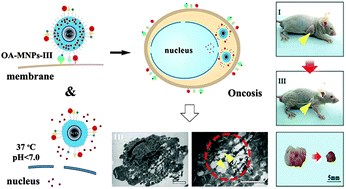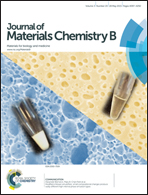Design of magnetic nanoparticles for hepatocellular carcinoma treatment using the control mechanisms of the cell internal nucleus and external membrane†
Abstract
Nanoparticle drugs and relevant treatment technologies have achieved widespread attention in recent years. Hepatocellular carcinoma (HCC) remains a challenging malignancy of worldwide importance since it is one of the worst malignant tumors. In this study, magnetic Fe3O4 nanoparticles are prepared via a co-precipitation reaction with self-assembled surface monolayers of oleic acid molecules. For synthesizing the nanoparticle anti-tumor drug used against HCC, the liquid photo-immobilization method is used to bond the photoactive N-isopropylacrylamide derivative (NIPAm-AA) onto the oleic acid monolayer for subsequently embedding doxorubicin, photoactive tumor necrosis factor-α (TNF-α)/interferon-γ (IFN-γ), and folic acid (FOL). We investigate how the nanoparticle drug inhibits the growth of human hepatocellular carcinoma HepG2 cells in vitro and in vivo. Remarkably, our characterizations show that the nanoparticle drug demonstrates much higher anticancer efficacy (94.7%) in vitro than previously reported drugs. It is revealed that the programmed cell death induced by the drug is mainly oncosis, a new programmed cell death pathway, different from earlier proposed mechanisms. This oncosis mechanism is also confirmed in the other two hepatocellular carcinoma cells (BEL-7402 and Huh-7). This study may be helpful for developing a new type of nanoparticle drug capable of assuring molecular control of both the cell inner nucleus and outer membrane as a means to enormously increase the drug efficacy in human hepatocellular carcinoma.


 Please wait while we load your content...
Please wait while we load your content...